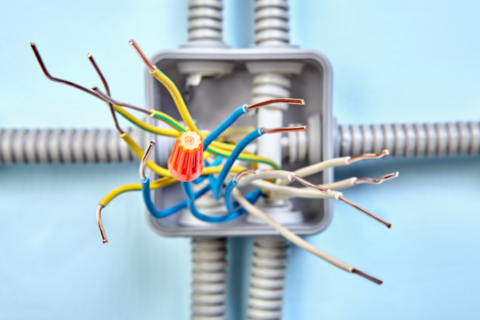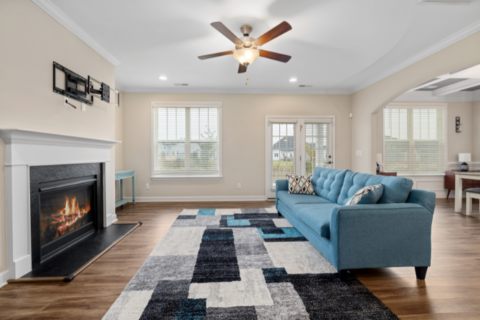Light Up Your Room with B&K Electric
How To Wire A Room With Lights And Outlets
Whether you are building a new home, renovating an existing one, or just looking to upgrade your current electrical system, learning how to wire a room with lights and outlets is a valuable skill to have. Not only does it save you money on hiring an electrician, but it also gives you the satisfaction of knowing that your home’s electrical system is safe and efficient.
As a family-owned and operated electrical business based in Warwick, Rhode Island, B&K Electric is rooted in community and dedicated to providing top-notch customer service. Our team of experienced electricians has been proudly serving the residents of Cranston, Warwick, and all of Rhode Island for over seventeen years. Specializing in electrical repair, panel maintenance, and installation, we are your go-to electrician for all your residential and business needs in the Warwick and greater Providence area.
Before we delve into the process of wiring a room with lights and outlets, it is important to understand the basics of electrical wiring. The electrical system in your home is made up of wires, circuits, and panels. Wires carry electricity from the main electrical panel to the outlets, switches, and lights in your home. Circuits are the pathways that the electricity travels through, and the main electrical panel is where the circuits originate from. Now that you have a basic understanding of the electrical system, let’s get into the steps of wiring a room with lights and outlets.
Step 1: Plan the Layout
The first step in wiring a room is to plan out the layout of the lights and outlets. Start by drawing a floor plan of the room and marking the location of all the lights and outlets you want to install. It is important to consider the purpose and function of the room when deciding on the placement of lights and outlets. For example, a kitchen may require more outlets for appliances, while a living room may need more lighting for proper ambiance.
Pro Tip: In rooms with high ceilings or hard-to-reach areas, consider adding a ceiling fan with a built-in light fixture, which can provide both lighting and air circulation.
Step 2: Gather Materials and Tools
Once you have a well thought out plan, it is time to gather the necessary materials and tools. You will need a voltage tester, wire stripper, electrical tape, wire nuts, a hammer, and a drill. You will also need wiring, outlets, and switches, all of which can be purchased at a local home improvement store. Make sure to check the electrical specifications for your area to ensure you are using the correct wiring and outlets.
Pro Tip: Always turn off the power before starting any electrical work. It is also recommended to use a voltage tester to double-check that the power is off before proceeding.
Step 3: Install the Outlets
Using your floor plan as a guide, determine the location of the outlets and use a circuit tracer to identify the correct circuit to connect them to. Begin by turning off the power to the circuit at the main electrical panel. Then, using the voltage tester, check that there is no voltage running through the wires. Next, drill holes in the wall where the outlets will be installed and feed the wiring through the holes.
To install the outlets, strip the insulation off the end of the wire and connect them to the outlet using wire nuts. The black wire is the live or hot wire, and it connects to the brass-colored screw on the outlet. The white wire is the neutral wire and connects to the silver-colored screw, and the bare copper wire is the ground and connects to the green screw. Once the wires are securely connected, attach the outlet to the wall with screws and install the outlet cover.
Pro Tip: To make sure your outlets are installed correctly, use a circuit tester to check that the polarity is correct, and make sure the outlet is grounded properly.
Step 4: Install the Switches
To install the switches, follow the same process as the outlets for stripping the insulation off the wires and connecting them to the appropriate screws on the switch. However, switches only require two wires, a hot wire and a switch leg, which is connected to the black screw on the switch. To ensure that the switch is installed correctly, you can test it with a voltage tester before turning the power back on.
Pro Tip: When wiring multiple switches in one box, make sure to label the wires to prevent confusion.
Step 5: Install the Lights
Now that the outlets and switches are installed, it is time to wire the lights. Feed a piece of wiring from the light fixture through the hole in the ceiling where the light will be installed. Then, strip the ends of the wire and connect them to the corresponding wires of the light fixture with wire nuts. The black wire connects to the body of the light fixture, the white wire connects to the neutral wire, and the grounding wire connects to the green screw on the light fixture.
Pro Tip: Use wire hangers to support the light fixture while connecting the wiring to prevent it from being damaged.
Step 6: Connect the Wires to the Main Panel
Once all the lights and outlets are installed and connected, the final step is to connect them to the main electrical panel. Start by turning off the power to the main electrical panel and installing the circuit breakers for the new circuits. Then, strip the insulation off the ends of the wires and connect them to the corresponding circuit breakers. Once all the wires are connected, turn the power back on and test each outlet and switch to ensure they are functioning properly.
Pro Tip: Label the circuit breaker for each new circuit for easy identification in the future.
Conclusion:
Wiring a room with lights and outlets may seem like a daunting task, but with the right tools and knowledge, it can be a manageable DIY project. However, if you are not confident in your ability to do it yourself, it is always best to hire a licensed electrician to ensure the safety and efficiency of your electrical system.
At B&K Electric, we understand the importance of a safe and reliable electrical system in your home. With our team of experienced and friendly electricians, we are committed to providing top-notch service to all our clients in North Providence, Rhode Island, and the surrounding areas. Contact us today for all your electrical needs, and let us bring light to your home.
Topics:


